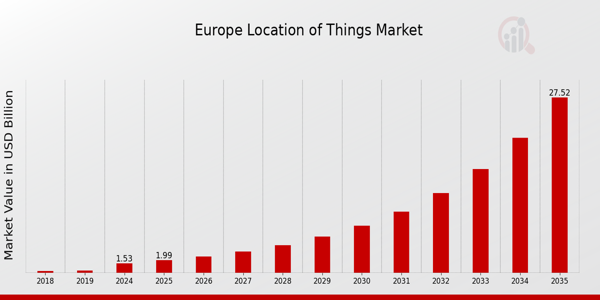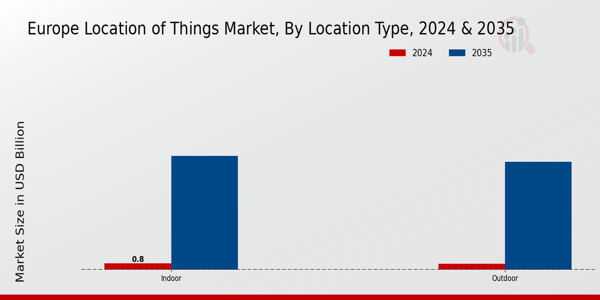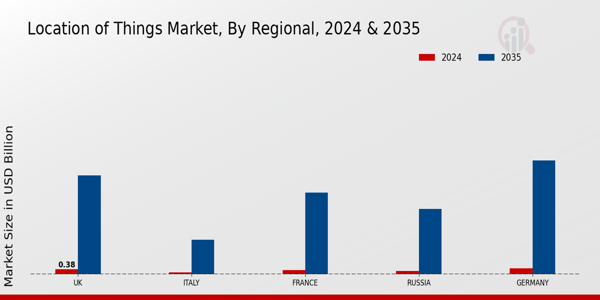
Europe Location of Things Market Overview:
As per MRFR analysis, the Europe Location of Things Market Size was estimated at 1.18 (USD Billion) in 2023.
The Europe Location of Things Market Industry is expected to grow from 1.53(USD Billion) in 2024 to 27.52 (USD Billion) by 2035. The Europe Location of Things Market CAGR (growth rate) is expected to be around 30.043% during the forecast period (2025 - 2035).
Key Europe Location of Things Market Trends Highlighted
The Europe Location of Things Market is experiencing a shift driven by the increasing adoption of Internet of Things (IoT) technologies, which enables precise tracking and management of assets. Governments across Europe are actively promoting smart city initiatives that leverage location data to enhance urban planning and transport efficiency. This regulatory support acts as a key market driver, encouraging businesses to integrate location-based solutions into their services. Additionally, the growing emphasis on sustainability and resource management is pushing companies to adopt location technologies to optimize logistics and reduce their carbon footprint.
Opportunities abound as more sectors explore the potential of location-based services. For instance, healthcare organizations are looking to enhance patient care through improved asset tracking, while retailers are using location data to personalize customer experiences and streamline operations. The rise of 5G technology is also opening new avenues for real-time location services, enabling faster data processing and connectivity across various applications. Recent trends indicate a notable increase in the deployment of geospatial analytics within industries such as transportation and logistics, agriculture, and energy management. Companies are recognizing the importance of data-driven decision-making and are investing in tools that provide actionable insights from location data.
Furthermore, collaborations between private firms and public institutions are becoming common as they work towards shared goals in improving infrastructure and services. These trends highlight the dynamic landscape of the Europe Location of Things Market, underscoring its potential for growth and innovation in the region.

Source: Primary Research, Secondary Research, Market Research Future Database and Analyst Review
Europe Location of Things Market Drivers
Growing Demand for Real-Time Location Data
The growing usage of location-based services in a variety of industries, including retail, transportation, and healthcare, is driving up demand for real-time location data in the Europe Location of Things Market Industry. About 70% of companies in the area are now using location-based services to improve customer experience and operational efficiency, according a research by the European Commission. Businesses who invest in technology that uses the Internet of Things (IoT) for real-time tracking and data analytics, such as Vodafone and Tele2, are at the forefront of location data service improvements.
This rapid adoption indicates that the European market is pivoting toward a more data-centric approach, urging other businesses to integrate location services, thus driving market growth significantly.
Government Initiatives Supporting Smart City Projects
In Europe, government initiatives aimed at developing smart city projects are significantly boosting the Location of Things Market Industry. The European Union has earmarked substantial funding to develop smart city technologies, with a goal to reduce carbon footprint by 20% by 2025. Countries like Spain and the Netherlands have initiated projects utilizing IoT and location services to improve urban infrastructure. Notably, the Smart Cities Mission in the UK aims to enhance public transport and energy management through location-based platforms.
With increasing investments from public authorities and the integration of smart technologies, the growth of the Location of Things market in Europe is being catalyzed through these visionary government efforts.
Increasing Integration of IoT Devices
The extensive integration of IoT devices across various industries in Europe is another key driver for the Location of Things Market Industry. A study by the European Telecommunications Standards Institute illustrated that IoT device connections in Europe are predicted to reach approximately 2 billion by 2025. Prominent technology firms, including Siemens and Bosch, are actively developing IoT solutions that incorporate advanced location tracking capabilities to enhance operational efficiency.
This integration significantly influences how businesses operate, driving the uptake of location-based solutions. The mass adoption of IoT technologies, therefore, serves as a critical factor propelling the growth of the Location of Things market within the European landscape.
Rising E-Commerce and Logistics Optimization Needs
The explosive growth of e-commerce across Europe is creating unprecedented demands for logistics optimization, directly benefiting the Location of Things Market Industry. In 2020, e-commerce sales in Europe reached over 700 billion Euros, with a projected increase of 20% annually according to Eurostat. Major e-commerce platforms like Amazon and Zalando are increasingly employing location analytics to streamline their delivery operations and enhance customer satisfaction.
This trend highlights the urgent need for solutions that provide real-time visibility into shipping and inventory levels, driving the adoption of location-based technologies. The intersection of booming online sales and logistics efficiency requirements continues to fuel the growth trajectory of the Location of Things market in Europe.
Europe Location of Things Market Segment Insights:
Location of Things Market Location Type Insights
The Europe Location of Things Market is characterized by distinct segmentation based on Location Type, primarily targeting Indoor and Outdoor applications. This market is witnessing a significant transformation driven by the increasing integration of smart technologies and the growing demand for enhanced data accuracy in location-based services. As urbanization accelerates across Europe, both Indoor and Outdoor segments are crucial to leverage real-time tracking and management solutions, catering to various sectors, including retail, transportation, and smart city infrastructure.
The Indoor segment, which caters to businesses and consumers looking for precise location services within enclosed environments, is seeing heightened interest. This can be attributed to the growing adoption of technologies such as Bluetooth beacons, Wi-Fi positioning, and RFID, enhancing customer experiences and operational efficiencies in retail, event management, and logistics. On the other hand, the Outdoor segment plays a vital role as it encompasses a broader scope, enabling location-based services across vast geographical areas, including navigation, fleet management, and outdoor advertising.Moreover, outdoor applications are increasingly reinforced by the expanding capabilities of GPS technology, drones, and IoT devices, which are integral for location intelligence. Collectively, both segments contribute to the evolving landscape of the Europe Location of Things Market, uncovering numerous growth drivers and driving a trend towards more connected environments. The interplay between Indoor and Outdoor applications signifies not only technological advances but also the growing emphasis on data security and privacy in the realm of location services across Europe.
As industries adapt to meet consumer needs, the importance of this segmentation continues to rise, positioning the Europe Location of Things Market favorably for future innovations and expanded usage across diverse sectors.

Source: Primary Research, Secondary Research, Market Research Future Database and Analyst Review
Location of Things Market Regional Insights
The Europe Location of Things Market showcases significant potential across various countries, with certain economies playing vital roles in shaping market dynamics. Germany holds a prominent position, driven by a strong industrial base and technological advancements, making it a key player in the deployment of location-based services. The UK continues to innovate, reflecting robust growth potential owing to its diverse economy and focus on Research and Development in location technologies. France is notable for its commitment to smart city initiatives, which enhances the importance of the Location of Things Market in urban planning and service delivery.
Meanwhile, Russia offers unique opportunities with its vast geography, fostering demand for location tracking and management solutions. Italy and Spain contribute to market growth through advancements in logistics and transportation management, where location services enhance operational efficiencies. Lastly, the Rest of Europe contains emerging markets demonstrating increasing adoption of location technologies across various sectors, thereby enriching the overall landscape of the Europe Location of Things Market. The market benefits from growing demand for enhanced navigation, asset tracking, and improved consumer experiences, amid evolving regulatory frameworks and the rise of Internet of Things applications in the region.

Source: Primary Research, Secondary Research, Market Research Future Database and Analyst Review
Europe Location of Things Market Key Players and Competitive Insights:
The Europe Location of Things Market has been experiencing significant growth driven by advancements in IoT technology and increasing demand for data-driven insights across various sectors. As businesses and consumers alike recognize the importance of geolocation in enhancing operational efficiency and user experience, the market has become highly competitive, attracting a range of players that offer innovative solutions. The integration of advanced analytics and artificial intelligence with location data has empowered organizations to optimize resource utilization, improve customer engagement, and streamline supply chain processes. This dynamic environment has led to the emergence of key players that differentiate themselves through unique offerings, partnerships, and targeted strategies tailored to the specific needs of European markets.
In the Europe Location of Things Market, Microsoft stands out for its robust cloud infrastructure and commitment to providing comprehensive analytics solutions. The company’s Azure platform has positioned it as a leader in managing location data while offering powerful tools for businesses to gain insights into their operations and customer behaviors. Microsoft’s strengths lie in its ability to leverage its extensive ecosystem, making it easier for companies to integrate location intelligence into their existing workflows. Furthermore, Microsoft’s strategic collaborations with various industry players have expanded its reach and application of its location-based services across the continent, enhancing the overall value proposition it offers to clients. The firm's persistent investment in research and development allows it to continuously innovate and meet the evolving demands of the market, further cementing its prominent position in the European landscape.
Apple, on the other hand, has made significant inroads in the Europe Location of Things Market, driven primarily by its commitment to user privacy and seamless integration of location-based services within its product ecosystem. The company’s key products, including the iPhone and Apple Watch, not only facilitate everyday navigation but also engage users with advanced location-based applications and features. Apple’s strengths in this space include its ability to leverage its extensive customer base and strong brand loyalty, thus promising widespread adoption of its location services. The company has also engaged in strategic acquisitions to enhance its geolocation capabilities, focusing on developing technologies that ensure user data privacy while providing valuable insights. This focus has enabled Apple to carve out a niche in the market, appealing to consumers and businesses alike, particularly in Europe, where data protection is of paramount importance. As Apple continues to expand its services and refine its existing offerings, its emphasis on innovation and user-centric solutions positions it favorably within the competitive landscape of location-based technologies in Europe.
Key Companies in the Europe Location of Things Market Include:
Microsoft
Apple
Verizon
Bosch
IBM
TomTom
Nokia
Geotab
Amazon
SAP
HERE Technologies
Cisco
Siemens
Europe Location of Things Market Industry Developments
Recent developments in the Europe Location of Things Market have shown significant growth, particularly with companies like Microsoft and Google expanding their geographic services through enhanced cloud solutions and artificial intelligence capabilities. In September 2023, HERE Technologies introduced new platforms for fleet management, targeting the logistics sector, which has prompted interest from Geotab and TomTom in collaborative innovations. Additionally, in July 2023, Bosch announced a strategic partnership with Siemens to integrate smart building solutions using location services, aiming to enhance user experiences in urban settings. Notably, IBM engaged in a joint venture with Nokia in August 2023 to revolutionize 5G applications for indoor positioning. Furthermore, recent acquisitions have impacted market dynamics; in October 2023, Verizon acquired a small European software firm specializing in location tracking, boosting its technological capabilities in the sector. The overall market valuation within Europe has been on a steep rise, with estimates projecting continued expansion driven by increasing demand for smart city initiatives and supply chain optimization, reinforcing the importance of accurate location data within various industries.
Europe Location of Things Market Segmentation Insights
Location of Things Market Location Type Outlook
Indoor
Outdoor
Location of Things Market Regional Outlook
Germany
UK
France
Russia
Italy
Spain
Rest of Europe
FAQs
What is the market size of the Europe Location of Things Market in 2024?
In 2024, the Europe Location of Things Market is expected to be valued at 1.53 billion USD.
What is the expected market size of the Europe Location of Things Market by 2035?
By 2035, the market is projected to grow significantly to 27.52 billion USD.
What is the expected compound annual growth rate (CAGR) for the Europe Location of Things Market from 2025 to 2035?
The expected CAGR for the Europe Location of Things Market is 30.043 percent during the forecast period from 2025 to 2035.
What are the values of the indoor and outdoor segments of the market in 2024?
In 2024, the indoor segment is valued at 0.8 billion USD and the outdoor segment is valued at 0.73 billion USD.
What is the projected value of the indoor segment by 2035?
The indoor segment is forecasted to reach a value of 14.12 billion USD by 2035.
Which region is expected to dominate the Europe Location of Things Market in 2024?
Germany is expected to dominate the market with a share valued at 0.45 billion USD in 2024.
What is the expected market size for the UK in 2035?
The UK market is projected to grow to 7.15 billion USD by 2035.
Who are the key players in the Europe Location of Things Market?
Major players in the market include Microsoft, Apple, Verizon, Bosch, IBM, TomTom, Nokia, Google, Geotab, Amazon, SAP, HERE Technologies, Cisco, and Siemens.
What is the market size for France in 2024?
The market size for France is valued at 0.3 billion USD in 2024.
What is the projected value of the outdoor segment by 2035?
The outdoor segment is expected to reach a value of 13.4 billion USD by 2035.
Kindly complete the form below to receive a free sample of this Report
Customer Stories

“This is really good guys. Excellent work on a tight deadline. I will continue to use you going forward and recommend you to others. Nice job”

“Thanks. It’s been a pleasure working with you, please use me as reference with any other Intel employees.”

“Thanks for sending the report it gives us a good global view of the Betaïne market.”

“Thank you, this will be very helpful for OQS.”

“We found the report very insightful! we found your research firm very helpful. I'm sending this email to secure our future business.”

“I am very pleased with how market segments have been defined in a relevant way for my purposes (such as "Portable Freezers & refrigerators" and "last-mile"). In general the report is well structured. Thanks very much for your efforts.”

“I have been reading the first document or the study, ,the Global HVAC and FP market report 2021 till 2026. Must say, good info! I have not gone in depth at all parts, but got a good indication of the data inside!”

“We got the report in time, we really thank you for your support in this process. I also thank to all of your team as they did a great job.”

Leave a Comment